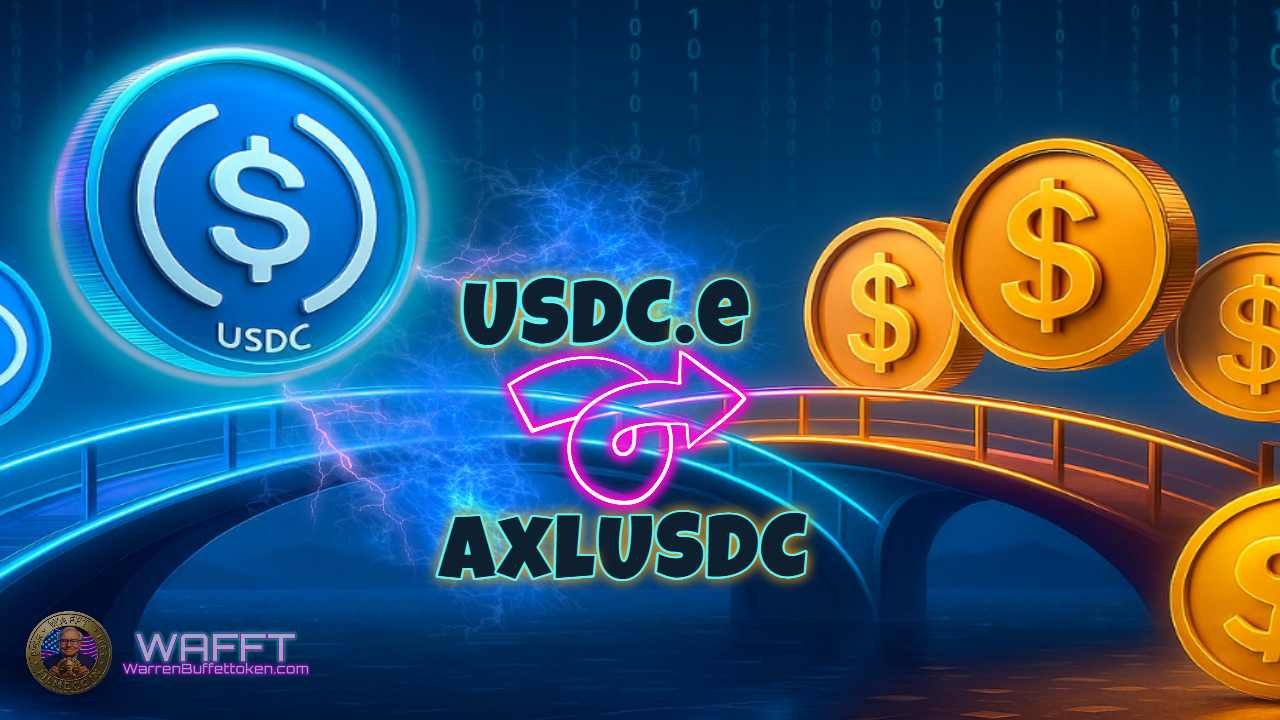Bridged Stablecoins — USDC.e, axlUSDC & Cross-Chain Dollars

WAFFT context note🗒️:
We use “USDC.e”as the classic example of a bridged stablecoin that fulfilled its purpose—bootstrappingAvalanchebeforenative USDC 🚀.
The pattern we explain here applies to any stablecoin that reaches a network via a bridge (🔗⛓️), such as axlUSDC, USDC.e on PolygonzkEVM, and many others.
🧐 What they are:
- 🔄 “Traveling” stablecoins: USDC/USDT that reach another network via a bridge.
✵ Examples: USDC.e (bridged USDC) or axlUSDC (USDC issued on the destination by Axelar’s bridge).

- 🧭 Not the native issuance: On that chain they are not minted by the issuer (e.g., Circle). They’re a representation of “original” USDC (home chain/domain) created by the bridge.
- 🏗️ How they appear (simple idea): On the origin chain, native USDC is locked (
lock); the bridge mints a copy (mint) on the destination chain (USDC.e, axlUSDC, etc.). On the way back, the copy is burned (burn) and the original is released (release).⚠️ Your bridged stablecoin is only as secure as the bridge that created it.
- 🧩 Standard format on destination: On EVM they show up as ERC–20; on Solana as SPL. That’s why they work in that network’s DEX, vaults, and money markets like any local token.
- 🏷️ Names and labels: Suffixes/prefixes help distinguish bridged versions and the bridge that created them:
.e(e.g., USDC.e) → bridged from another chain (used by Avalanche’s native bridge).axl(e.g., axlUSDC) → bridged by Axelar.so(e.g., soUSDC) → bridged by Wormhole (Solana).OFT/OFTv2→ bridged by LayerZero.(⬆️ A popular standard for omnichain tokens. Unlike other bridging standards, it often keeps the original token name (e.g., still «USDC«); always verify the token contract on a block explorer to confirm it conforms to the OFT standard.)
👉 The ticker can look similar, but the contract address/mint address is what matters.
- 🔢 Decimals: USDC usually uses 6 decimals (also in many bridged copies), but always verify the metadata (decimals/symbol) on the destination network.
- 🎯 1:1 parity (intention): Target: 1 bridged USDC ≈ 1 USD, backed by locked native USDC.
Note: direct redemption with the issuer (Circle) applies to native USDC only; for bridged versions you must use the bridge to return to the origin chain.

- ⚡Mini–example:
1. You have USDC (native) on Ethereum → bridge to Avalanche → you receive USDC.e.
2. To go back to native USDC, burn USDC.e on Avalanche via the bridge → USDC is released to you on Ethereum.

⚡WAFFT checklist:
✔︎ Bridge is trusted → correct contract address/mint address on the destination network → pool depth/liquidity → fees + return time → small test first.
💡WAFFTip: If you see USDC “with a last name” (.e, axlUSDC, etc.), think “bridged.” Verify the address in the destination block explorer using links from the bridge’s official site. Don’t confuse it with native USDC on that chain.
🔑 Key facts: Bridged Stablecoins on Major Chains
Avalanche C-Chain
USDC.e (Avalanche Bridge)
🔢 Decimals: 6
🧾 Contract Address:
0xa7D7079b0FEaD91F3e65f86E8915Cb59c1a4C664(legacy bridged).Refs: Snowtrace USDC.e
Native USDC (Circle–issued):
0xB97EF9Ef8734C71904D8002F8b6Bc66Dd9c48a6EaxlUSDC (Axelar)
🔢 Decimals: 6
🧾 Contract Address:
0xfab550568C688d5D8A52C7d794cb93Edc26eC0eC(always verify).Refs: Snowtrace axlUSDC / Axelar Docs
OP Mainnet & Arbitrum
axlUSDC (Bridged via Axelar)
🔢 Decimals: 6
🧾 Contract Address:
0xeb466342c4d449bc9f53a865d5cb90586f405215(same on both networks; always verify).Refs: Etherscan OP / Arbiscan / Axelar Docs
Native USDC Contrast (Circle–issued): Verify addresses in Circle’s Docs.
Polygon PoS
USDC (Bridged via Polygon Bridge)
🔢 Decimals: 6
🧾 Contract Address:
0x2791bca1f2de4661ed88a30c99a7a9449aa84174(legacy bridged version; always verify).Refs: Polygonscan USDC
Native USDC Contrast (Circle–issued):
0x3c499c542cEF5E3811e1192ce70d8cC03d5c3359

🚨 WAFFT Critical Notes:
Suffixes/prefixes are bridge–specific:
.e= Avalanche Bridgeaxl= Axelar BridgePolygon’s bridged USDC has no suffix (same name as native, different contract).
Native > Bridged:
Prefer Circle–issued native USDC whenever possible (e.g., on Polygon use0x3c499c542cEF5E3811e1192ce70d8cC03d5c3359). Native has no bridge risk.Bridge risk:
Bridged versions (e.g., USDC.e, axlUSDC) carry additional smart contract and bridge risks.Verify, verify, verify:
Always confirm contracts on block explorers (Snowtrace, Arbiscan, Polygonscan). Cross–check with official bridge docs (e.g., Axelar’s token list).
🛠️ How it works:
- 🧭 Origin vs. destination:
🔸 Origin = the chain where the USDC you’ll lock is native.
🔸 Destination = the network where you’ll receive a representation (USDC.e, axlUSDC, etc.).

- $ Accounting depends on the mechanism:
🔸 for lock–and–mint (third–party bridges), bridged supply on destination ≈ USDC locked on origin (minus fees).
🔸 For burn–and–mint (issuer–native routes like Circle’s CCTP), USDC burned on origin ≈ USDC minted on destination.
- 🔗 Practical sequence (step by step):
1. Lock (origin): you send native USDC to the bridge contract/program.
2. Attestation (message/proof): the bridge emits evidence of that lock.
3. Mint (destination): using that attestation, bridged USDC (ERC–20/SPL) is minted to your wallet.
4. Return: you burn on destination → the bridge releases native USDC on origin (or re–mints, depending on design).

- 🧩 Format on destination: On EVM it’s an ERC–20; on Solana it’s an SPL. You can use it on that network’s DEXs, money markets, and vaults like a local token (same interface ideas: approve, transferFrom, etc.).
🧾 Native redemption vs. bridged: If you need native USDC on a chain where the issuer officially supports it, bridged ≠ native. You’ll typically go back through the bridge to the home chain or use the issuer’s official burn–and–mint route to convert to native.

⚠️ Security, liquidity, and message relay/finality times depend 100% on the specific bridge/mechanism.
- ⚡ Lightning examples:
• USDC (Ethereum, native) → USDC.e (Avalanche): lock on Ethereum → mint USDC.e on Avalanche → use it → burn on Avalanche → release native USDC on Ethereum.
📝 WAFFT Note: Avalanche also has native USDC; always verify the official token address.

• axlUSDC (OP/Arbitrum): lock the native on origin → mint axlUSDC (ERC–20) on the L2 → operate → burn → release on the home chain.
👉 axlUSDC is an Axelar representation (trust model: Axelar’s validator/relayer set); it’s not the issuer’s native USDC.
- ⛽ Gas and real-world UX: Usually two transactions (one per chain). You pay gas in each network’s native coin.
Bridge UIs show progress (lock → message → mint/burn → release). Some UIs bundle steps, but they still execute across two chains.

💡 WAFFTip: USDC (native and many bridged variants) commonly uses 6 decimals.
Always verify on the destination explorer: token address (most important), symbol, decimals.
Mini-glossary 📚:
🔸Home chain: the chain where that instance of USDC is native (issued by the issuer).
🔸Bridged: a representation created by a bridge on another network.
🔸Lock & Mint/Burn & Release: lock and mint (outbound) /burn and release (return).
🔸Burn & Mint (issuer): burn on origin and mint on destination via the issuer’s route.
🔸Attestation: the message/proof that certifies a cross–chain event.
☆ At WAFFT Academy, we explain it this way: it’s like going through customs with a voucher you can use in another country; when you return, you hand it in and get your original dollars back. 💵🌉
💡 Why this matters:
- 🚰 Immediate dollar liquidity: Bring USD to chains where there’s no native issuance yet, so DEX, money markets, and payments can start from day one.
🧩 Immediate composability: As local ERC–20/SPL, they integrate instantly with the destination ecosystem’s DEX, vaults, lending, zaps, and routers/aggregators.

💸 Capital efficiency: They let you trade, pay, and use DeFi on the new network without selling your USD exposure or waiting for the issuer to deploy there.
🧭 Bridge to native when it arrives: When native USDC becomes available on that chain, migrating is easy: you redeem or swap from bridged → native following the official routes (often at 1:1). ⚠️ This process depends on the bridge and the issuer.
🧱 Unit of account and routing: They serve as a base pair (USD) for pricing and better swap routes in emerging ecosystems.
🧪 Real example: On Arbitrum, USDC.e (bridged) was used initially; on June 8, 2023, Circle launched native USDC and the migration from USDC.e to native began.
💡WAFFTip: These migrations are usually done via an official portal or the most liquid DEX, at a 1:1 ratio.
✩ WAFFT takeaway: They are the cold start for the on–chain dollar in new networks: they enable product and volume today, and leave the door open to migrate to native tomorrow. 🚀
💼 Use them for:
- 💱 Trading and payments: Use USDC.e/axlUSDC as a base pair and a means of payment on chains where there’s no native USDC or USDT yet. (e.g., invoice, get paid, and quote prices in USD from day one).

🌊 Liquidity in DEXs and AMMs: Provide liquidity to pools where the bridged variant has more TVL and higher 24–hour volume than local stables (and, if it’s v3 — i.e., Uniswap v3–style concentrated liquidity — good depth in your price range). (e.g., USDC.e/ETH or axlUSDC/WETH if they’re the dominant pairs.)
💡WAFFTip: Verify volumes and TVL on DeFiLlama or on the network’s block explorer.
⚙️ DeFi strategies: Deposit them in money markets, vaults, or perps (perpetual futures) when that bridged version is the market’s collateral/base (unit of account or primary collateral), for better compatibility and better rates.
🔄 Remember: The security of your bridged asset depends on the bridge that created it.
Quick examples ⚡:
• Swap at a better price because the router sends your trade through USDC.e (deepest pool).• axlUSDC as collateral → borrow ETH to trade.
• LP in USDC.e/ETH to capture fees where that pair is the market leader.
💡WAFFTip : On each chain, prioritize the bridged variant with the highest TVL and volume. If native USDC later arrives and gains depth, consider migrating (usually via a 1:1 swap on an official portal).
At WAFFT Academy, we play where the liquidity is. 🎮🚀

🧠 WAFFT Best Practices:
- 🎯 Liquidity strategy: Your golden rule: “Follow the volume, not the ticker.” Prioritize the stablecoin (native or bridged) with the highest TVL (total value locked), 24–hour volume, and depth in the pools you use.
👀 Liquidity > name.
- 🔄 Migration flow: Have a clear plan for when the native version arrives:
- Monitor official announcements from the issuer (Circle, Tether) or the network’s foundation.
- Migrate when volume shifts to the native asset and official routes (1:1 swaps) are available and liquid.
- Don’t rush—migrations typically have long windows. Wait until the new market stabilizes.
- Monitor official announcements from the issuer (Circle, Tether) or the network’s foundation.
- ⚖️ Risk/return assessment: Before using a bridged variant, ask:
- Is the trade–off worth it? Do the fees/returns I’ll earn on this chain justify the additional bridge risk and potential illiquidity?
- What’s the exit plan? How, and at what costs/fees, do I get back to my native asset or to fiat?
- Is the trade–off worth it? Do the fees/returns I’ll earn on this chain justify the additional bridge risk and potential illiquidity?
- 🧠 WAFFT mindset: Use bridged assets as a temporary bridge to the opportunity, not as a long–term store of value. Their purpose is to give you access to yield and products before the native standard exists. When the native arrives and matures, migrate.
WAFFT summary: It’s not just about verifying contracts (you already know that), but about choosing the best tool for each stage of the ecosystem.
At WAFFT Academy, we analyze first, then allocate capital. 🧮🚀
⚠️ Watch out for…
💱 Trading and payments: Use USDC.e/axlUSDC as a base pair and a means of payment on chains where there’s no native USDC or USDT yet. (e.g., invoice, get paid, and quote prices in USD from day one).

- ⚖️ Peg fragility under stress: In volatile or panic market conditions, bridged variants can trade at a discount (or premium) relative to 1 USD. This is amplified if liquidity is low or if there are doubts about the bridge. Monitor the effective price (including slippage and fees) in deep pools.
- 🔄 Migration transitions: When an issuer launches the native version (e.g., Circle’s USDC on a new chain), the ecosystem can fragment during the transition. The market may split between bridged and native, creating arbitrage but also temporary illiquidity. Follow official announcements to migrate in time.
- 🧾 The name is not a guarantee: “USDC.e” and “axlUSDC” sound official, but they are not issued by Circle. Only native USDC has direct backing from the issuer. Never assume a similar ticker implies the same backing; always verify the contract address.
- 🛰️ Bridge operational status: Before any operation, check the bridge’s official dashboard:
👉 are mint and burn functions active?
👉 Are there capacity limits or security alerts?If mint is paused, that’s a red flag. Use only bridges with recent activity and no incidents.

- 🔀 Official migration routes: When the native asset arrives, always use official portals or swaps to migrate from bridged to native. Avoid doing it through unofficial pools with low liquidity, where slippage can be high. Official routes usually offer a 1:1 exchange without losses.

⚡ WAFFT Checklist:
- Secure bridge? → Check audits and operational status.
- Sufficient liquidity? → Check TVL (total value locked) and the volume of the pair you’ll use.
- Stable peg? → Compare effective price (with fees) vs. 1 USD.
- Clear exit route? → Have a plan to return to native or to fiat.
✩ WAFFT summary: Bridged stables are powerful but transitional tools. Use them to access opportunities, but keep an exit plan and always prioritize bridge security.
At WAFFT Academy, we navigate with caution and data, not with faith. 🚤

🧭 WAFFT Refresher:
Bridged stables are your plan B when there’s no native issuance yet on that chain. Use them wisely — and follow this mini–checklist before deploying larger size:
🔸 Canonical contract: verify the checksummed address in the docs or official block explorer.
🔸 Native or bridged?: don’t trust the ticker — confirm the type and the issuer/bridge.
🔸 Decimals: it’s usually 6 for USDC/USDT; double–check the token’s metadata before use.
🔸 Peg ≈ 1 USD: Check the real swap price (including slippage and fees) in deep pools.
🔸 Liquidity: prioritize TVL, 24h volume, and depth on your chosen route.
🔸 Exit route: understand how to return to fiat or to native USDC (bridge or official swap) including its costs and timelines.
🔸 Small test: Always start with a small transaction to confirmation times, fees, and receipt before scaling up.

At WAFFT, we insist: trust, but verify.That’s how you enjoy instant liquidity without losing control of your risk. 💵✨
👉 Up next: explore Wrapped Assets Across Blockchains — wSOL, wETH & Use Cases and learn how assets from different networks work together, unlocking composability, liquidity, and new cross–chain strategies. 🌐🧩


